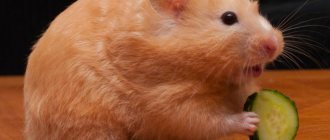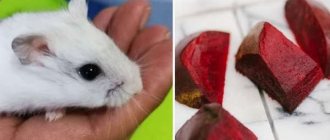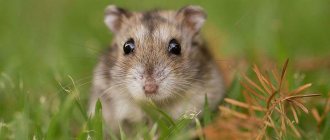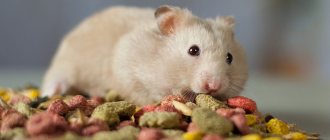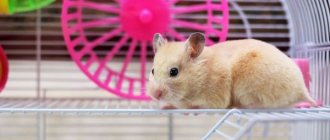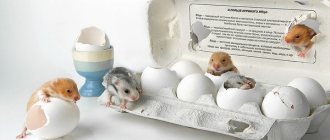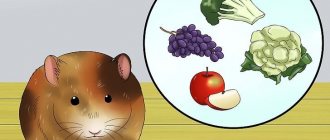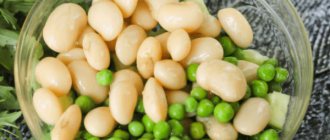When it comes to vegetarian treats, you're probably wondering, can hamsters eat carrots? It's true that there's nothing more adorable than a furry hamster nibbling on a vegetable treat. A hamster eating carrots not only sounds cute, but it's also the perfect healthy snack.
In fact, in moderation, carrots can be a nutritious addition to your hamster's food. However, hamsters are foragers, which means you need to know how to safely feed carrots to hamsters and avoid health risks to your hamsters.
Is it possible to give hamsters carrots?
Rodents need to be given carrots regularly. Allowed for daily consumption. In addition, the pet will receive additional moisture from this vegetable.
Small hamsters can be given carrots as soon as they begin to eat dry food on their own. And for a pregnant hamster, this is a must-have product in the diet.
Hamster eats carrots
In what quantity: cut a circle from the carrot, 1-1.5 cm thick, and give it to the animal. Do not try to give more, the hamster will begin to stockpile, and the vegetable may quickly rot or dry out. In any case, such a product is unsuitable for food, and midges may also appear in the house.
Can hamsters eat carrot tops?
Many hamster care websites list carrots as a safe and healthy treat for hamsters. However, little veterinary advice has been written about carrot tops.
It seems that hamster owners regularly feed carrot tops to their hamsters without any problems. This suggests that it is probably safe to feed hamsters a small amount of carrots from time to time. Some owners want to feed their hamsters carrot tops because they don't want the carrot tops to go to waste.
Do not give your hamster the whole carrot top. This is too much food and it will most likely rot in your hamster's cage. Instead, feed a small amount of carrot tops to see if your hamster likes them. Some hamsters find carrot tops not as attractive as the carrots themselves.
Useful properties of carrots for a hamster
| Compound | Pros for the rodent |
| Vitamin A | Supports vision and immune system. |
| Vitamin C | Increases immunity, prevents colds. |
| Vitamin K | Has a beneficial effect on the hamster's circulatory system. |
| Potassium and dietary fiber | Normalization of the gastrointestinal tract. |
Carrots for Djungarian and Syrian hamsters
Carrots are as beneficial for Djungarian hamsters as for others. You should definitely give your dwarfs carrots also because these babies are susceptible to increased blood sugar levels and related problems with excess weight. This vegetable will help avoid such troubles.
Djungarica needs carrots to maintain optimal health.
The Syrian hamster also needs to get its share of vitamins and minerals, so don’t be afraid to offer your pet an orange treat.
Raw or boiled: what kind of carrots should you give your hamsters?
Overall there is not much difference. Raw contains more nutrients and vitamins. But it needs to be washed and cleaned well. It is preferable to give vegetables from your own garden. In the warm season, you can try growing some carrots on the balcony.
Store-bought carrots can be treated with pesticides and other harmful substances that will not harm humans, but may harm the health of a tiny animal.
If you have no choice, then store-bought carrots must be soaked in cold water for at least 3 hours to remove most of the harmful substances.
Hamsters can also be given boiled carrots, but do not do it often, because when cooked, there is practically no benefit from the vegetable. Raw carrots are dense and help to wear down the animal’s teeth, which grow throughout its life.
Delicious carrots for a hamster
If you still decide to give a piece of boiled vegetable, then you should not do it from your soup or other dishes. It is necessary to cook without salt and spices.
If you have an electric dryer, you can prepare root vegetables for the winter and add them to your main grain feed throughout the year.
How to properly include it in your diet
The optimal amount of fresh root vegetables for daily nutrition is a circle 1 cm thick.
You should not give your hamster carrots in large quantities - the baby will not finish it, but will hide it in his bins. Subsequently, the treat will begin to rot and spoil other food in the cage.
This should not be allowed, because eating stale food is fraught with severe poisoning.
To feed small animals, it is better to use vegetables grown in your own garden. If this is not possible, and you have to give your hamster carrots from the store, you must rinse them thoroughly, peel off the top layer and soak the pieces of root vegetables in water for 3-4 hours. During this time, all harmful substances that entered the vegetable during cultivation and storage (when treated with pesticides or preservatives) will dissolve in the water.
Some owners are interested in whether hamsters can have cooked carrots. Yes, such vegetables can be given to an animal (only if they are cooked without salt), but he will not receive any benefit from them. During cooking, most of the beneficial substances will be destroyed.
Properties of the root vegetable
This root vegetable, exceptional in composition, has a lot of positive properties:
- beta-carotene, which is transformed in the body into vitamin A, helps maintain normal vision, promotes growth, prevents diseases of the liver, joints, stomach, and endocrine system (which is especially good for the Djungarian breed of rodents);
- phytoncides have a bactericidal effect;
- Potassium and dietary fiber normalize kidney and intestinal function.
The benefits of this vegetable for small rodents are undeniable and are not limited only to nutritional value. Giving hamsters carrots is a must. Solid treats help babies avoid overgrowth of their incisors. When a hamster chews a carrot, it wears down its ever-growing teeth.
Pathological hair loss: causes and symptoms
Hair loss in an animal can be provoked both by the influence of certain environmental factors and by certain diseases that provoke malfunctions in the rodent’s body. It is extremely important to identify the cause of the problem. This will help determine what to do if your hamster is going bald.
Stress
This animal is quite shy. It loves silence and solitude. The following can cause stress in a hamster:
- moving;
- rearrangement in the cell;
- house replacement;
- the appearance of a new pet;
- diet changes, etc.
In addition, rodent anxiety is often caused by human actions. Hamsters are nocturnal. During the daytime they sleep. Loud noises, music and other noise can frighten a rodent and affect its mental state. During periods of stress, the animal's glands may become more active. This often leads to hair loss in certain areas of the body. Most often, bald spots form on the head and abdomen.
Stress can cause an animal to shed.
Poor nutrition
The hamster's body does not produce many types of vitamins. In addition, he does not always receive all the necessary minerals from food. A monotonous diet can negatively affect the condition of the coat. Poor nutrition often causes the development of dysbiosis in hamsters. This negatively affects the absorption of nutrients in the intestines.
Hair loss due to vitamin deficiency is more often observed in hamsters that have consumed only dry food consisting of cereals for a long time. It does not contain enough vitamins and minerals for the normal functioning of the animal.
Vitamin deficiency is often accompanied by hair loss on the rodent's ears. In this case, there are no signs of an inflammatory process. The skin in bald areas is very flaky. To eliminate the problem, it is important to adjust the rodent’s diet.
Fungus and skin parasites
Even with regular cleaning of a hamster's cage, there is a risk of your pet becoming infected with fungus or skin parasites. Pathogenic microorganisms may be contained in feed or bedding. Fungal infections often affect older rodents with weakened immune systems.
The first signs of the disease do not appear immediately. About a month after infection, bald patches appear on the sides, face and ears. The lesions are initially smooth and have clear boundaries. Subsequently, signs of an inflammatory process appear. Without treatment, purulent formations form on the animal’s skin, covered with scabs on top.
The progression of the disease causes great discomfort to the pet. He experiences severe itching, so he scratches the affected areas. In addition, the hamster's appetite worsens, it becomes lethargic and irritable. When the first signs of infection appear, you need to contact a veterinarian to conduct tests and clarify the type of fungus that has affected the skin of the rodent. Only after this can effective treatment be prescribed.
Skin parasites often cause baldness in hamsters. Pets are more often infected with scabies mites. Parasites provoke not only hair loss, but also severe itching. Because of this, the hamster begins to scratch the lesions that bother him. Bald patches often form on the ears, cheeks and near the anus. Subsequently, a secondary infection occurs, which leads to the formation of plaque and scabs. The hamster loses his appetite. In severe cases, fungal infections and skin parasites cause the death of the animal within a few weeks or months.
Allergy
If your hamster itches and goes bald, the problem is often an allergic reaction. It can be triggered by toys in the cage, new food, or hygiene products used when cleaning the house. It is extremely difficult to determine exactly what caused the allergic reaction. In most cases, to fix the problem, you need to adjust the animal's menu and remove all recently purchased toys and accessories from the cage.
Allergies can also cause baldness.
Hormonal disbalance
Pregnant females often experience hair loss due to a lack of vitamins and minerals in the body. Correcting the diet and special supplements can quickly eliminate this problem. In addition, females may lose fur on their belly and chest during the postpartum period. This is a natural mechanism that makes it easier to warm and feed the offspring.
If a female has symmetrical bald patches, the problem may lie in diseases of the reproductive organs. Often hair falls out with pyometra, i.e. purulent inflammation of the uterus, as well as endometritis.
Less commonly, the appearance of bald patches is caused by ovarian tumors. At the same time, females do not suffer from itching and other unpleasant sensations.
Weakening of the immune system
Hair loss in a hamster may indicate a malfunction of the immune system. The problem may be caused by:
- avitaminosis;
- lack of vaccinations;
- sudden change in diet;
- irregular cleaning of the cage;
- stress;
- acute and chronic diseases;
- previous surgery;
- injuries;
- antibiotic treatment;
- parasitic infestations, etc.
A weakened hamster's immune system not only leads to the formation of large bald patches, but also creates conditions for the development of bacterial, viral and fungal infectious diseases. If the problem is caused by a disorder of the immune system, not only the condition of the coat worsens. The animal becomes lethargic, its appetite decreases and its weight decreases. The pet spends most of its time in its house.
Abscesses
Infection in the subcutaneous fat of a hamster can provoke the formation of a purulent abscess. A similar disorder often develops if a rodent combs its fur. This defect is formed when the hair follicle becomes infected with microflora from the rodent’s oral cavity.
First, hair falls out over the site of the abscess formation. The affected area takes on a reddish tint. It becomes warmer to the touch. Light flaking may be present.
Gradually the focus increases. A mature abscess in most cases opens on its own, which leads to the leakage of pus and cleansing of the wound. If this does not happen, you need to contact a veterinarian to open the formation, sanitation and prescribe a course of antibiotics and external treatment. After the wound heals, the fur is restored.
At the site of the abscess formation, the rodent combs out the fur.
Irritation from urea
The appearance of a bald patch on the lower abdomen and hind legs may be due to the systematic contact of the animal’s urine on its skin. The integuments acquire a red tint and begin to peel off. Frequent urination often occurs against the background of inflammatory diseases of the bladder. To eliminate the problem, you need to consult a veterinarian to prescribe comprehensive treatment.
Wool abrasion
Bald patches on the back of the head and paws can occur if the hamster often runs in a narrow maze. If the rodent is able to stick its head between the bars of the cage, the hair falls out on the neck. To solve the problem, you should purchase accessories that are suitable in size for the animal. In addition, you may need to purchase a cage with a high, smooth plastic tray.
Age-related alopecia
Some rodents have a genetic predisposition to balding in old age. This feature is passed on from one generation to another. In this case, alopecia lesions begin to appear in related hamsters at approximately the same age. Special vitamin supplements will help slow down the process of hair loss.
List of prohibited products
You should not give white cabbage to dzungarians to eat, it causes increased gas formation and is difficult to digest. There have been cases when it caused the death of a poor rodent. Limit khoma from potatoes, they are too hard to digest and can contain huge amounts of pesticides, plus they have too much starch.
Remember that any branches of fruit trees collected in the city can seriously harm the dzhungarika, having a detrimental effect on health. Given our ecology, this fact does not even require explanation.
Good quality twigs can be purchased at pet stores, but be sure to heat them before giving them to your rodent.
Under no circumstances give Djungarian hamsters food from your table. Fried, fatty and floury foods are very harmful to his health.
Below, in the list, we will take a closer look at the foods that should not be given to Djungarian hamsters, these are:
- Salt.
- Pepper.
- Sugar.
- Honey.
- Onion.
- Watermelon.
- Sour cream.
- Chocolate.
- Kiwi.
- Pomegranate.
- Mint.
- Sorrel.
- Cherry or apricot pits.
- Coniferous tree branches.
- Sausage.
- Bread.
- Cookie.
- Pasta.
- Garlic.
- Almond.
- Milk.
- Cheese.
There is a lot of debate about foods that should or should not be included in a hamster's diet, with one half arguing for harmlessness or healthfulness, and the other taking the opposite point of view. These products include beets, radishes and bananas.
In any case, the choice will be yours; if you have concerns about giving this or that food, it is better to refuse than to reproach yourself for what you have done. After all, the list of products that are completely harmless for Djungarian hamsters is quite extensive.
Basic rules for feeding small rodents
The latest statistics from zoologists say that most of the hamsters living at home die due to gastrointestinal diseases and nutritional problems. This, of course, is due to improper feeding of animals. Many people, when buying a pet for a child or a home pet, do not even think about the correct composition of the diet and feed what is offered at the nearest pet store or, even worse, what is on hand at home. This is a gross mistake, and before taking a hamster into your home, you must definitely study its nutritional habits, what it eats and how it lives in the wild, and what its gastrointestinal tract is adapted to. Let’s look at the basic rules of how to feed, a list of what can and cannot be given, as well as what Djungarians like to eat.
The first and most important rule is that you need to feed your pet at a certain, constant time. Many zoologists argue about when it is better to set the main meal for Dzungarik: in the morning or in the evening. Most say that in the evening, since hamsters are nocturnal animals. But here it is best to find a middle ground and give food to the animal twice a day - in the morning and in the evening. This way the pet will always be full, which is important for such small animals that have a very fast metabolism.
The second condition for eating Dzungariks at home is variety. Make sure that the animal’s diet is as complete and varied as possible, and that the food meets the body’s needs. If the animal refuses to eat some product you offer, then it is better to replace it with another. For example, if your hamster loves to eat bananas rather than apples, then you can spoil your furry. You only need to exclude your favorite product if it causes gastrointestinal disturbances.
It is also important not to overfeed Dzungarik. An empty bowl does not mean that the pet is hungry. The fact is that all hamsters tend to hide food in reserve. If you rummage around in the bedding, in the house or in another secluded place of the cage, you can find many such reserves. Hamsters often like to hide food in their cheek pouches. Therefore, you need to feed exactly as much as the norm.
For Dzungariks, the daily food intake is a tablespoon of dry grain food, as well as small pieces of vegetables, fruits and herbs as additives.
Other vegetables
Don't forget to supplement your pet's diet with other healthy vegetables. They will not be among the basic ones, but if consumed 1-2 times a week they will bring tangible benefits to his body.
Eggplant
Recommended for fresh consumption, it is usually alternated with other vegetables, offering the hamster no more than 50 grams at a time. When purchasing, avoid overripe fruits - eggplants are useful because they restore the water-mineral balance in the animal’s body; unripe and stale fruits are not suitable for this.
Pumpkin
Contains a lot of fiber, beta-carotene, good for the eyes, phosphorus, iron, potassium. Useful as a treat even for overweight animals and diabetics. But, unlike carrots, it is not suitable as a daily food.
Pumpkin should diversify the diet, and not become its basis; it is useful in fresh, stewed, boiled form. Be sure to have no peel - it is cut off in a thick layer.
When baking, pumpkin should not be seasoned with oil, spices or salt. This puts a lot of strain on the liver of a rodent, which in nature does not eat such things.
Zucchini
It is one of the dietary products recommended fresh without peel. For sick, weakened, young animals (up to 6 weeks), it is useful to puree it with a blender.
Zucchini cannot be the basis of the daily diet - veterinarians advise alternating it with other juicy vegetables: cucumbers, eggplants, pumpkin.
Zucchini and pumpkin seeds deserve special attention. This healthy treat will help the rodent cope with parasites, as it has anthelmintic properties.
Cucumbers and tomatoes
Both vegetables are beneficial for hamsters, but there are nuances to their introduction into the diet.
Cucumber
Allowed fresh 1 time per day, daily intake – up to 50 grams. Store-bought cucumbers are peeled and pre-soaked. Give it to young animals up to 2 months with caution, observing the reaction of the still immature gastrointestinal tract.
Young cucumbers are 90% water, helping to cope with excess weight and normalize digestion. The minerals in them strengthen bones, teeth, B vitamins – the nervous system, but most importantly, they remove toxins and heavy metal salts.
Tomatoes and cherry tomatoes
Tomatoes are useful for digestion, respiratory function, cleansing blood vessels and capillaries. They protect the hamster from cancer due to the content of lycopene and antioxidants. Strengthen nerve fibers and have a beneficial effect on the hematopoietic organs. They contain a lot of iodine for the thyroid gland and magnesium for the heart. They are given fresh without peel 1-2 times a week; preference is given to tomatoes from your own plot, grown without the use of chemicals.
In Syrian hamsters, tomatoes can provoke or aggravate arthritis; it is better not to give these rodents tomatoes.
Cabbage and its varieties
Syrian hamsters are prohibited from introducing it into their diet - the structural features of the gastrointestinal tract do not allow them to digest cabbage fibers.
Djungarian and Roborovsky hamsters can be offered the following types during the season (from August to November) 2-3 times a week, 50 grams each:
- colored (fresh, boiled);
- Beijing (fresh);
- broccoli (fresh).
You can read more about the formation of the diet of Djungarians and Syrians in separate articles.
It is not recommended for hamsters to include white cabbage in the menu - it causes fermentation in the intestines. And red-headed varieties are strictly prohibited - death is possible due to bloating.
Why is it useful?
Carrots contain many vitamins. These are both very well-known (B1, C, B2) and less common, but also necessary (K, B6, PP, E, P). In addition to them, the product includes phosphorus, iodine, protein, chromium, calcium, iron, carotene, and other elements so necessary for the hamster’s body.
Carrots are also hard; they help animals sharpen and train their incisor teeth for chewing food. By nature, the pet loves to chew on everything that comes to hand. A piece of carrot can be a good alternative to cage bars. And this will not only protect him, but also provide you with peace and quiet.
In addition, carrot juice also contains beneficial substances. It also helps animals quench their thirst. If you give it to animals regularly, they will never have problems with a lack of moisture in the body.
This is interesting: Do polar bears live in the Arctic?
How does natural molting occur in hamsters?
If a little hair remains on your hands when stroking a rodent, this does not always indicate problems with the animal’s health. This situation is often the result of natural shedding. At this time, the animal can completely or partially change its coat. The rate of hair loss depends on the conditions of detention, as well as the breed of the rodent. There are 2 main types of shedding:
- seasonal;
- age.
Seasonal shedding in hamsters occurs more often in spring and autumn. Breeds that hibernate change their coat during the summer. The pet renews its fur gradually. The process lasts for 2 weeks, so many owners of such rodents do not notice these changes and do not know whether the hamsters shed or not. During the renewal process, the color of the coat may change depending on the season.
Age-related molting is typical for both young individuals and old ones. The first renewal of the coat occurs approximately in the 4th month of the animal’s life. At this time, the soft fluff covering the hamster's body changes to a harder and denser cover.
The average lifespan of an animal is 2 years. As you age, your fur begins to fall out more rapidly, without having time to renew itself. This causes the cover to become less dense.
It is quite simple to distinguish natural shedding from pathological hair loss in a hamster. In the first case, hairs die off on all parts of the animal's body. In this case, large bald spots do not form. In addition, the naturalness of the process is indicated by the absence of scratching and itching. In this case, the hamster eats normally and behaves actively. Natural molting does not affect his health.
Benefit
So, we have already found out whether hamsters can eat carrots. Now you need to figure out what benefit or harm it will bring to your pet. Of course, eating a vegetable such as carrots will bring great benefits and will have an impact not only on the appearance, but also on the overall development of the pet.
In addition to the main food, each animal requires additional feeding, which consists of vegetables, fruits and some minerals. But, if your pet is hungry and there is nothing at hand, then carrots are the best option. The vegetable contains vitamins B, PPE, C, which are involved in metabolic processes and protein synthesis in the blood. Also, thanks to carotene, which is part of the vegetable, the body can receive vitamin A, which is responsible for vision and proper growth.
Delicious feeding is a must
The benefits that a hamster will get from eating a vegetable are very great:
- improvement in general condition: the animal is constantly energetic and full of strength;
- thanks to the richness of vitamins in carrots, the animal’s spring condition improves: the coat becomes smooth and silky, and the claws are strong;
- Rodents can also wear down their teeth on hard vegetables, which is very useful for such animals.
The main food of Djungarian hamsters
What is included in the dry mixture?
- Oats.
- Hercules.
- Corn.
- Seeds.
- Nuts.
- Peas.
The Djungarian hamster may not immediately evaluate the brand of the mixture; sometimes, to find the optimal option, you have to go through several brands. Usually one package of store-bought mixture lasts for one and a half or two months.
Some owners prepare grain mixtures themselves. In this case, they dilute the above composition with buckwheat, beans, lentils, and barley. It is not forbidden to add melon, pumpkin or sunflower seeds to such food.
Hamsters love nuts; you can add nuts, cashews, chickpeas, sesame seeds, and hazelnuts. Do not forget about the quality of such a mixture; all products must be fresh.
Plant food
Fruits in syrup, compote berries, and jam should not be offered to rodents. Any preserved food is prohibited because it contains sugar and salt. Raw seasonal fruits are preferred for feeding. Some of them are placed in the cage boiled (zucchini, beets, carrots, pumpkin). The cooking time in this case is minimal. The water is not salted.
If fresh fruits and vegetables are purchased at the store, it is better to cut off the skin (it often contains pesticides). For home harvest, this step is not necessary. Plant foods, including those from your own garden, must be thoroughly washed. After all, harmful bacteria and helminth eggs may remain on its surface.
All fruits must be fresh, not chapped, and free of rot. The pits of cherries, apples, cherries, plums, and apricots must be removed. The hamster can be poisoned by them. If a pear, pepper or other delicacy is cut into several pieces, the remaining pieces are stored in the refrigerator for several days.
It is important to remember that excessive fruit feeding causes indigestion and increased gas formation in hamsters, and increases the risk of diabetes and obesity. In small quantities, fruits help strengthen the immune system, improve intestinal motility, and are involved in the prevention of many diseases.
Article on the topic: What to feed a Syrian hamster at home, what can be given and what cannot be given
